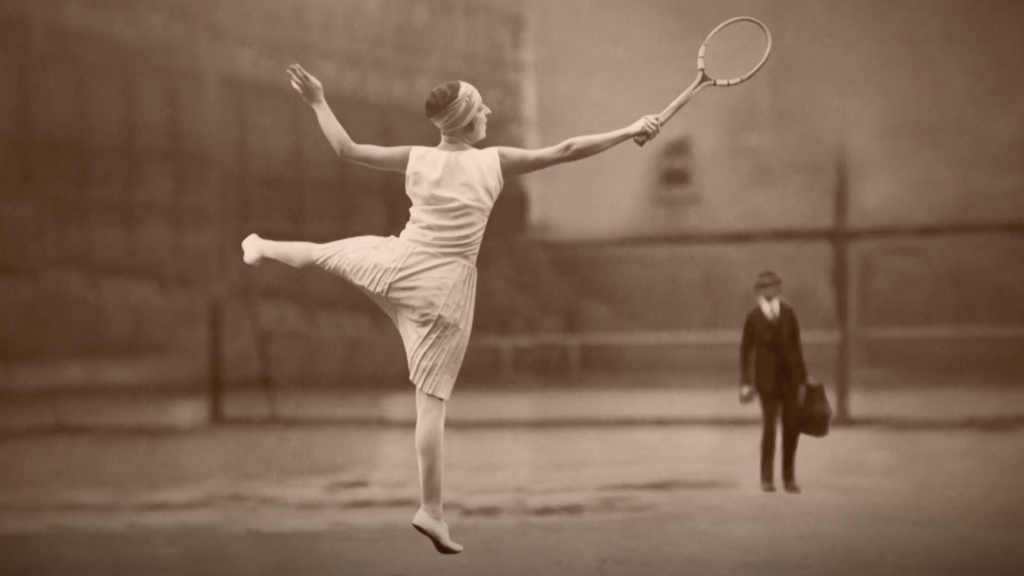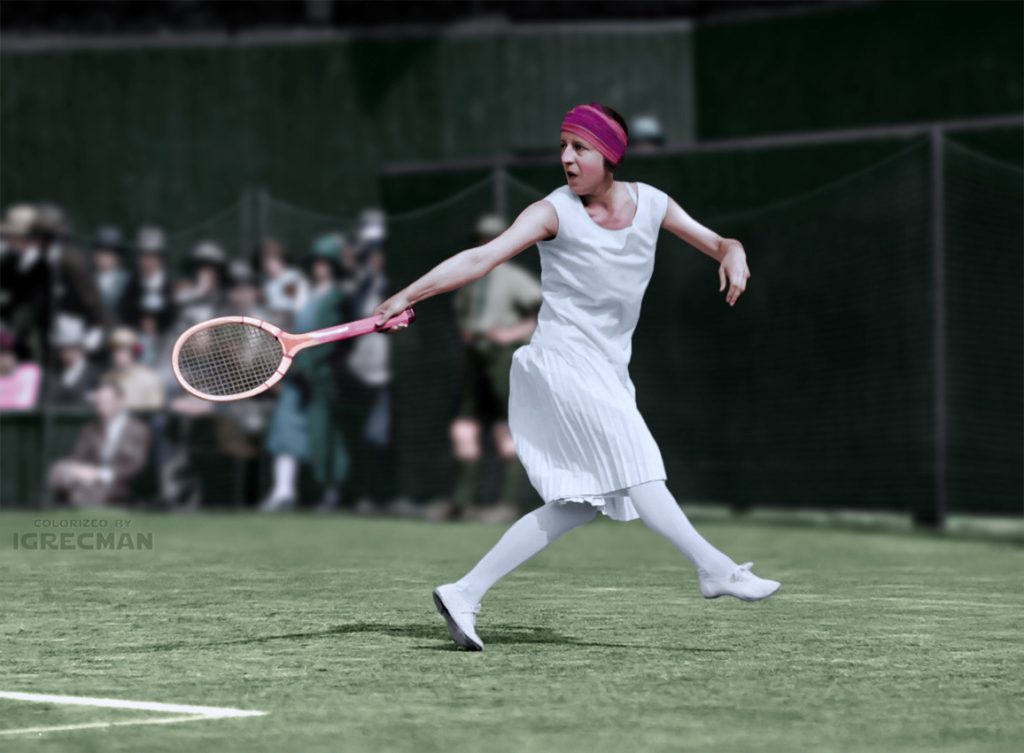
Colorization credit: Women’s Tennis Colorizations
I’m counting down the 128 best players of the last century. It’s like an advent calendar, only I keep the chocolate.
* * *
Suzanne Lenglen [FRA]Born: 24 May 1899
Died: 4 July 1938
Career: 1912-27
Played: Right-handed (one-handed backhand)
Peak rank: 1 (1921)
Major singles titles: 8 (4 World Hard Court titles)
Total singles titles: 83
* * *
Now we enter the realm of myth.
Back at the beginning of the Tennis 128 project, a friend encouraged me to mix in an April Fool’s essay. I immediately thought of the famous George Plimpton prank, “The Curious Case of Sidd Finch,” published by Sports Illustrated in 1985.
Finch was a Buddhist, french horn-playing baseball pitcher who could throw a fastball 168 miles per hour. The New York Mets brought him to Spring Training, where he fretted over his destiny and the potential injuries that his fireball might cause. There was no doubt he would succeed on the diamond. No one could see his pitches, let alone hit them. Of course, Sidd Finch was nothing more than a figment of Plimpton’s imagination.
What is the tennis equivalent? Perhaps a player who simply never missed a ball, one who could place any shot on a handkerchief laid within inches of the opposite baseline? A force of nature who seemed to be playing a different sport than the rest of the circuit, one who could enter tournament after tournament for years on end without losing a single match?
It would be possible–just–for a youngster to arrive out of nowhere, capable of smacking a serve harder than Sam Groth, looping a forehand with more RPMs than Rafael Nadal, and chasing down a drop shot faster than Lauren Davis. Those tools would, indeed, amount to an unthinkably perfect tennis player. But nothing really worked. It took me a couple of weeks, and a few pages full of fruitless notes, to figure out why the joke of a racket-wielding Finch would inevitably fall flat.
It wouldn’t be satire. We got our flawless champion one hundred years ago. Someone with a style that seemed to come from a future generation, with the skills to match. Someone who so comprehensively outplayed the field that hapless foes counted their triumphs in mere points. Games, if they were lucky.
Her name was Suzanne Lenglen.
* * *
Helen Jacobs saw one of the last public matches Lenglen ever played. “There seemed to be no chink in her armor,” she wrote, “no position on the court in which she was not the master.”
“When you saw her play you did not know how good she was because it looked so easy,” wrote Helen Wills Moody. “It was only from the other side of the net that you realized how really good she was. Her control and delicacy of placement will probably never be equaled.”
“She never made a mistake, in stroking or tactics,” said five-time Wimbledon champion Charlotte Cooper Sterry. “She was like a cat playing with a mouse.”
Elizabeth Ryan told a reporter in 1941: “I had the best drop shot anybody ever had. But she could not only get up to it but was so fast that often she could score a placement off of it. She had a stride a foot and a half longer than any known woman who ever ran.”
“At first, I was disappointed, as were most of those who saw her for the first time after having heard so much about her,” wrote René Lacoste. “She played with marvelous ease the simplest strokes in the world. It was only after several games that I understood what harmony was concealed by her simplicity, what wonderful mental and physical balance was hidden by the facility of her play.”
“Suzanne could beat any woman any day by any score she wanted,” said Bill Johnston. “She was by far the best woman player ever.”
* * *
It is impossible, from our 21st century vantage point, to fully grasp Lenglen’s greatness. She won her first Wimbledon in 1919, when most other women players wore whalebone corsets, and venturing to the net was almost as audacious as exposing an ankle.
Suzanne’s father, Charles, was the original overbearing tennis dad. Like Richard Williams, he noticed that tennis prowess and wealth seemed to go hand in hand. Never mind that, in the 1910s, champions earned no prize money–that would work itself out. Suzanne had a surfeit of athletic gifts–she was the French high jump champion in 1919, to name just one–and Charles channeled them into her tennis.
Charles’s key insight was that his fleet-footed daughter didn’t have to play like a stodgy middle-aged lady. The Lenglens spent part of each year in Nice, where they could watch the strong British and Continental players who gathered on the Riviera every winter. Charles ignored the ladies and studied dashing men players like Max Decugis and Tony Wilding. They played the net; they attacked.
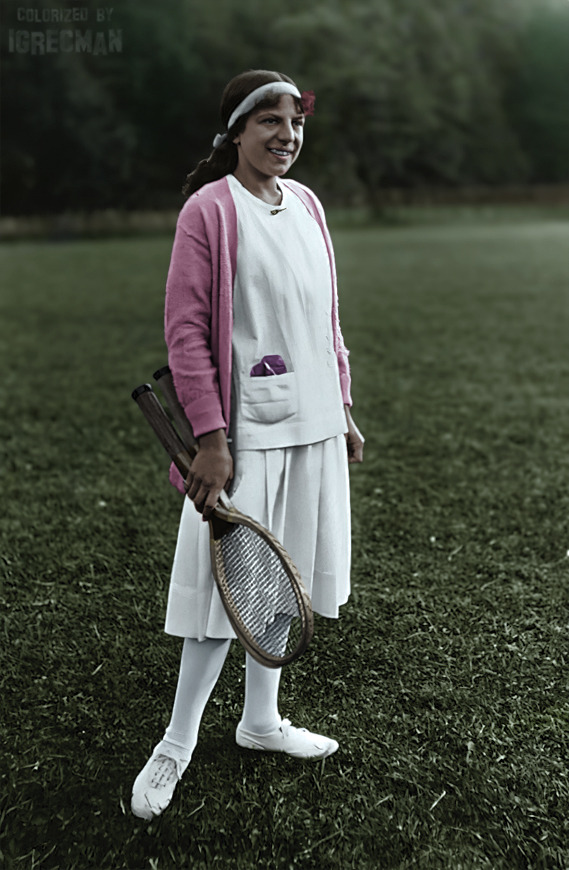
Colorization credit: Women’s Tennis Colorizations
Under her father’s careful eye, Suzanne mastered every stroke in the arsenal. When the rudiments were in place, Suzanne practiced almost exclusively with men. In 1918, the 18-year-old Lenglen beat 1911 French champion André Gobert in a casual match, 6-1, 6-1. Even though Gobert was out of form, convalescing after a wartime air crash, it was a remarkable feat for a young woman. A year later, journalist Al Laney saw her play doubles with three men. “She was the equal of the men in everything but severity,” he later wrote, “and their superior in mobility and accuracy.”
By then, other women didn’t stand a chance. Suzanne won her first adult title in 1913. She picked up her first trophy on the Riviera in 1914. She lost only to the strongest players on the circuit: Ryan, seven-time Wimbledon winner Dorothea Lambert Chambers, and French titlist Marguerite Broquedis. Her defeat at the hands of Broquedis in the Challenge Round of the 1914 French Championships was the last time she lost a completed singles match.
We’ll never know what Lenglen would’ve achieved between 1915 and 1918. The Great War wiped out tennis across Europe. But it wasn’t a complete loss. While Suzanne sometimes said she spent her time rolling bandages for the troops and hardly picked up a racket, plenty of eyewitnesses attested to daily practice sessions in Nice.
The Riviera circuit was back in full swing in 1919. I have results for 16 matches Lenglen played as she won six tournaments in France that spring. Here are the scores:
6-1 6-1
6-1 6-1
6-0 6-0
6-0 6-1
6-0 6-0
6-0 6-1
6-0 6-0
6-0 6-0
6-0 6-0
6-0 6-0
6-0 6-0
6-0 6-1
6-0 6-0
6-0 6-0
6-0 6-1
6-0 6-1
Laney wrote of Suzanne’s later years as a global celebrity: “Just to see her crush some unfortunate girl 6-0, 6-0 was an event.”
There would be a lot of events like that.
* * *
Most of Lenglen’s post-war matches were little more than exhibitions of Suzanne’s otherworldly skill. It didn’t matter. She quickly became perhaps the most famous sporting figure up to that point in history, her every move tracked by reporters and fans.
She was invariably compared to a dancer. No one had ever seen such acrobatics on a tennis court, especially from a woman. She made sure that people noticed, lunging and pirouetting when it wasn’t necessary. “[A]ll those crazy leaps she used to take were done after she hit the ball,” said Ryan. “Sure, she was a poser, a ham in the theatrical sense.”
The press treated her like a prima ballerina. They dubbed her “La belle Suzanne,” or simply, “La Divine”–the goddess. Charles, and later Suzanne herself, carefully avoided overexposure, limiting her tournament entries on the Riviera. Annual will-she-or-won’t-she chatter drove up demand and ensured that the Lenglens collected substantial under-the-table payments for her presence.
No woman’s appearance was more hotly debated. US champion Hazel Wightman said, “She was so homely–you can’t imagine a homelier face.” No one really disagreed, and cartoonists could do a particularly nasty job on her nose.
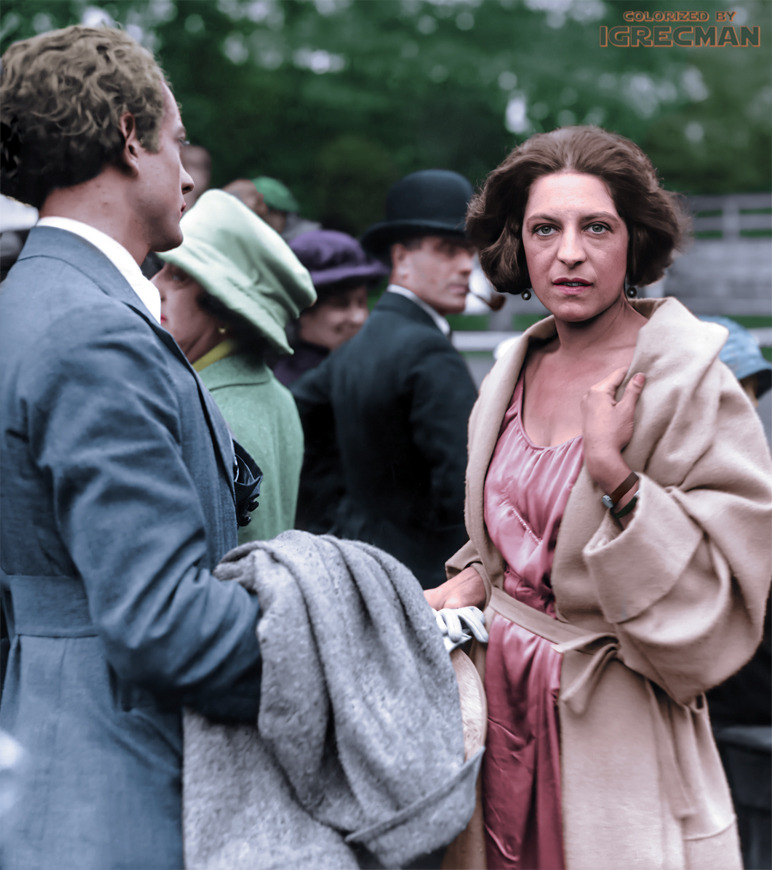
Colorization credit: Women’s Tennis Colorizations
But when Suzanne came to life, no one could look away. Her charisma was such, Laney wrote, that she could “[take] the attention away from dozens of women far prettier.” Couturiers lined up to dress her. When she started wearing headbands, she kicked off a global rage.
Fans flocked to her matches in such numbers that architects had to rethink stadium design. When Lenglen first appeared at Wimbledon, the tournament made the mistake of putting her on Court 4. Admirers “trampled the shrubbery” in their quest to see her. If she so much as practiced, spectators would abandon a match in progress just to spot La Divine in the flesh.
Ironically, Suzanne’s name is now on the secondary stadium at Roland Garros. No sensible tournament director would’ve dared to schedule her for the second-biggest anything. When Wimbledon moved to Church Road in 1922, it finally had a show court worthy of Lenglen and her tribe. Fans lined up a mile deep to see her on the new Centre Court.
* * *
That first year at Church Road, Lenglen won her fourth consecutive Wimbledon singles title. She beat Molla Mallory 6-2, 6-0 in less than half an hour. One newspaper said that the Norwegian-American “played shrewdly, courageously and probably as well as she ever played.” For 26 minutes.
Most of Suzanne’s match reports go something like that. She came, she saw, she obliterated.
Three post-war matches stand out. Between them, they tell us as much about La Divine as all those double-bagel victories combined.
First, the 1919 Wimbledon Challenge Round. The Lenglens elected to skip Wimbledon in 1914, fearing that Suzanne wasn’t quite ready to handle grass courts. The next four editions were canceled, so anticipation had reached its shrubbery-trampling level by 1919. The young Frenchwoman delivered as promised, winning her first match 6-0, 6-1, and taking the all-comer’s final against Phyllis Satterthwaite with the loss of just two games.
In those days, the previous year’s champion–the “holder”–advanced directly to the final, known as the Challenge Round. The woman who advanced through the all-comer’s draw would take on the holder for the title. 40-year-old Dorothea Lambert Chambers had won Wimbledon seven times, and she waited in the 1919 Challenge Round on the strength of her 1914 title.
Lambert Chambers represented the corsetted, baselining old guard with aplomb. The “solid magnificence of her driving”–according to the London Times–was enough to keep her even with Lenglen for most of a marathon battle. Lenglen fought off a set point to win the opener, 10-8. In the second set, Suzanne approached the net a bit too recklessly and committed a few uncharacteristic double faults. Lambert Chambers took the second, 6-4.
Lenglen recovered in the third after her parents tossed a small vial of cognac and she borrowed a linesman’s chair for a brief rest. The “scientific accuracy” of the ladies continued. Lambert Chambers aimed to break down Suzanne’s strength, peppering her forehand. The Frenchwoman attacked her opponent’s backhand, always looking for an opening to move forward. The challenger’s only weakness was a bit of overexcitement. While Lambert Chambers gave her groundstrokes a margin of safety, Lenglen often saw her own drives land a few inches beyond the baseline.
The defending champion earned two match points. Suzanne saved both, the first with a lunging volley off the frame of her racket. The youngster finally pulled ahead in the 16th game, winning the final set and the championship, 10-8, 4-6, 9-7.
Not bad for Suzanne’s first-ever tournament on grass.
Any lingering doubts about Lenglen’s stature–or, let’s be honest, her divinity–were put to rest a year later. In the 1920 Challenge Round, she faced Lambert Chambers again. It wasn’t so complicated this time. Suzanne defended her title, 6-3, 6-0.
* * *
The second critical match was her one post-war loss. La Divine made her first trip to the United States in 1921, nominally to stage some exhibition matches for the benefit of French war victims.
Nothing went right. She was ill, and her trip was delayed. Her father didn’t make the trip at all. Instead of arriving in America with time play a few matches and get a feel for the different turf and balls in use across the Atlantic, she docked just a few days before the US National Championships began.
Some players would’ve been unaffected. Suzanne was not one of them. Her defining characteristic–perhaps even more than her impeccable play–was her nervous fragility. Jackie Smyth, in his biography of Jean Borotra, wrote that she was “very highly strung and lived on her nerves–and sometimes on a little drop of cognac at times of crisis.”
(As fans discovered during the 1919 Challenge Round, a sip of cognac could work wonders. In 1921, prohibition was in force: Alcohol sales were illegal in the United States. Suzanne wasn’t about to forego a daily glass of wine, much less a necessary on-court fortification. Her visit was so important that the USLTA made arrangements for the authorities to look the other way.)
Draws were not yet seeded in 1921. Lenglen pulled US top-tenner Eleanor Goss in the first round and–the worst luck of all–five-time American champion Molla Mallory in the second. Goss withdrew, possibly as part of a coordinated strategy to ratchet up the pressure on Lenglen. The Forest Hills committee scheduled the Lenglen-Mallory match as early as possible.
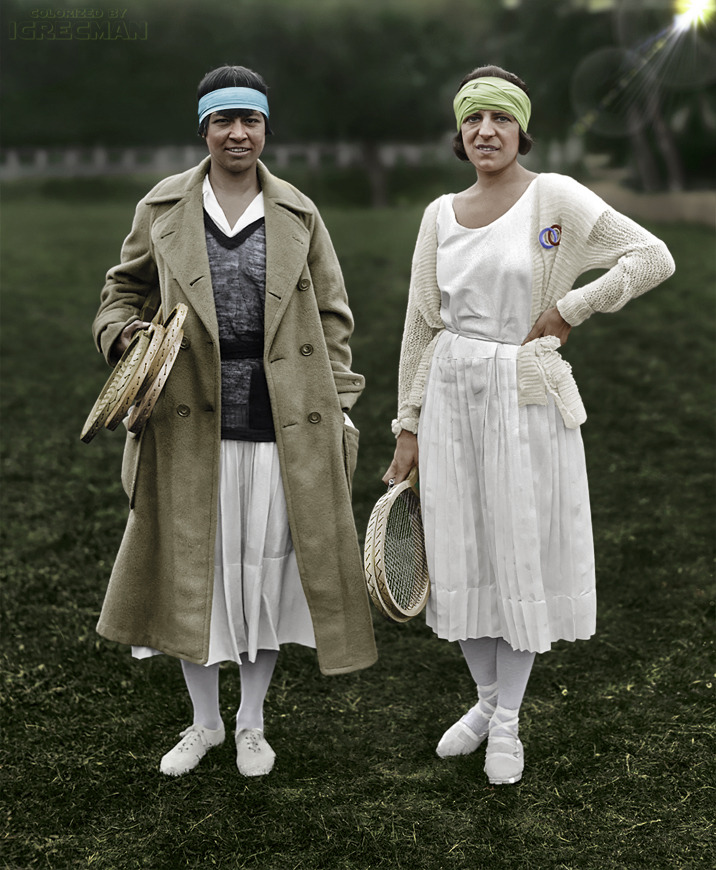
Colorization credit: Women’s Tennis Colorizations
Molla came out swinging, and Lenglen was unusually passive. Midway through the first set, Suzanne began coughing. After Mallory won the first set, 6-2, the visitor looked even weaker. Lenglen appeared fit enough to play, just not well. Certainly not to her usual standard. She elected to retire from the match without completing a game in the second set.
It was Suzanne’s one post-war loss as an amateur. The ensuing war of words lasted far longer than the single set the two champions contested. Lenglen was seen on the East Coast social circuit, often dancing the night away as long as she remained in the country. But her health seemed to betray her whenever a match beckoned. She never did play the promised exhibitions.
The papers dubbed her “cough-and-quit.” Americans celebrated their adopted champion Mallory, who went on to win her sixth Forest Hills title. The French, for their part, commissioned a report from a friendly physician to attest to Suzanne’s infirmity.
The Forest Hills episode illustrated the one weakness of La Divine. Lambert Chambers later said that the outcome of the 1919 Challenge Round was doubly tragic. For her, it meant the end of her reign as champion. For Lenglen, it meant impossibly high standards, expectations of invincibility that no human could meet. When things occasionally did go wrong, she withdrew from tournaments–though never again, for the remainder of her amateur career, in the middle of a match.
As much as those no-shows garnered headlines, they remained few and far between. And Suzanne never forgot Molla’s abbreviated win. The next year, when she dispatched Mallory at Wimbledon in 26 minutes, I can only imagine her shots carried a little extra sting.
* * *
Suzanne, like any great performer, saved the best for last. The third defining clash of her career was more than just that, it was the Match of the Century.
Lenglen spent most of her amateur career as the undisputed queen of tennis. How could she be anything else, when she won every match she played? Women like Kitty McKane Godfree, Elizabeth Ryan, and Phyllis Satterthwaite piled up victories against the field, then struggled to win more than a game or two against Suzanne. Godfree lost to La Divine in the 1925 Wimbledon semi-finals, 6-0, 6-0. Leslie Godfree said that his wife had never played better.
Helen Wills was the one woman with the potential to knock Suzanne off her perch. The slugging Californian won the US title every year from 1923 to 1925. When Lenglen skipped the 1924 Paris Olympics, Wills waltzed to the singles gold medal.
A clash between the two was inevitable, but neither woman was in a rush. Lenglen’s withdrawals from Wimbledon and the Olympics in 1924 raised eyebrows. Wills didn’t go to Europe in 1925.
Helen made the trip to the French Riviera in 1926. Suzanne remained cagey, opting to play only doubles in some early events. At last, at the Cannes Carlton Club tournament in February, both women progressed to the final. Lenglen lost just two games in four matches to get there; Wills dropped only five.
The anticipation–even before it was clear that the ladies would face off in Cannes–was intense. Reporters from around the world descended on the Riviera. They hounded the 20-year-old Wills, who had the good sense to remain silent. It was as much a cultural and political event as a sporting one. France felt hard done by in their post-war economic slump, and to some, America was the prime bully. La belle Suzanne was the pride of their nation, the artist who would prove the country’s superiority over the upstart Americans.
When the match finally took place, the sleepy coastal resort was overrun. A half-built grandstand was mobbed. The demand for news–anything–was unceasing. Sitting in the crowd waiting for the match to begin, Tom Topping of the Associated Press dispatched messengers with updates as fast as he could write them, aiming to get the latest developments in American papers before morning editions were put to bed.
The contest did not disappoint. Lenglen took the first set, 6-3. It was evident that Wills was the harder hitter of the two, though she didn’t quite possess Suzanne’s variety. The Frenchwoman discovered that Wills was hesitant to hit her backhand down the line and that she wasn’t fast enough to chase down the best drop shots.
Still, things were tight enough to merit a sip of cognac during the interval.
Helen raced to a 3-1 lead in the second, but she gave back the break when she opted to play more conservatively. Lenglen finally broke again at 5-all, and she earned two match points on her own serve. On the first, a long rally ended when a Wills forehand was called out. Both women ran to the net to shake hands, but it was only another twist. The linesman clarified that the ball was in; a spectator had made the out call.
(How exhaustively was this match covered? We know the names of all the line umpires. The man who made the critical correction was Lord Charles Hope, one of only three linesmen who doesn’t merit a Wikipedia page. When he wasn’t officiating monumental tennis matches, Lord Hope was an amateur golf champion.)
If ever there were a moment for La Divine’s nerves to collapse entirely, it was now. She hung on, but barely. Wills won the next three points to reach 6-all. Lenglen recovered to win a ten-point game for 7-6, then allowed Wills two chances to break back, one of them by double-faulting at deuce. Finally, on her third match point, another drop shot won the day. Suzanne squeaked it out, 6-3, 8-6.
A couple of hours later, the two women faced off again in the doubles final. Armed with a stronger partner, Lenglen won again, 6-4, 8-6.
The two women never again met on a tennis court.
* * *
The Match of the Century was the beginning of the end for Suzanne. She didn’t play another singles match on the Riviera. In April she went to Rome, where she won a title without the loss of a single game. In Paris, she won her sixth French championship. She dropped only four games in five matches.
At Wimbledon, though, it all came apart. She was nervous, she was ill, she was peeved that the French federation insisted she play with a countrywoman instead of her usual sidekick Elizabeth Ryan. Due to a scheduling mix-up, Lenglen didn’t appear on court when expected, and she gave the impression that she snubbed the Queen. She withdrew after two rounds, and she would never play an amateur match again.
Instead, Suzanne accepted an offer to turn pro. American promoter C.C. Pyle didn’t know anything about tennis, but he knew how to sell a superstar. Pyle signed up a troupe of standout players, including Vinnie Richards, to tour North America. Facing Lenglen would be Mary Browne, the former national champion who Suzanne discarded in the French final a few months earlier.
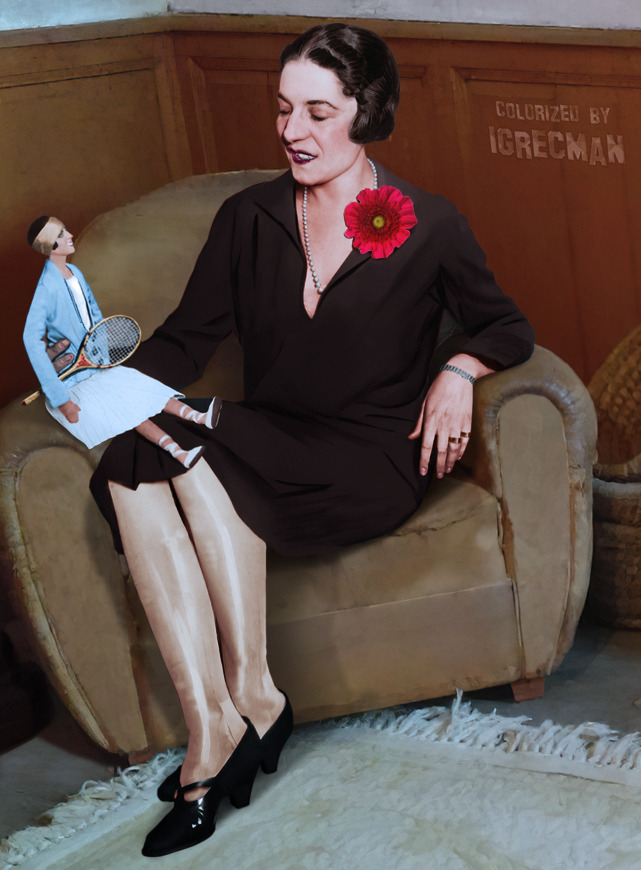
Colorization credit: Women’s Tennis Colorizations
La Divine’s return to the States was a sensation. Opening night in New York City was a gala event, with everyone from politicians to Broadway stars to Bill Tilden in attendance. Lenglen allowed the challenger just three games, an indication of what was to come.
Like the professional tours that would follow for the next four decades, it was considerably different from what Suzanne was used to. They made 25 appearances in two months. Pyle had promised Lenglen that she’d never be asked to play on consecutive nights. That lasted about seven weeks, until it was suddenly crucial to perform in Wichita the night after an exhibition in Kansas City. By December, Suzanne was sufficiently worn out to walk away from a match in Portland, Oregon after winning the first set, 11-9.
She ultimately played about 40 professional singles matches, collected a sizeable sum for her efforts, and faded–as much as a divinity could–into obscurity.
* * *
So, uh, 14th?
I get it. It’s unimaginable to consider Suzanne Lenglen the 14th greatest anything. Detractors might call her ugly, they might call her a showboat, they might even call her a quitter. But it never would’ve occured to her worst enemy to call her number fourteen.
It’s like calling Albert Einstein history’s 14th best physicist. Maybe it’s true. I have no idea. But it sure doesn’t sound right.
The Tennis 128 lives by the algorithm, and alas, we die by the algorithm. Suzanne’s competition was generally weak, and her career was short. None of this is her fault, but the fact remains that she rarely proved herself against top-level competition.
I did make some allowances. Elo will never capture the dominance of a player who wins literally every match. After she went 179-0, the formula could give us a lower bound of her abilities, but no more. I devised a method a few years ago to estimate Elo ratings for this sort of undefeated stretch. At the time, I was thinking about Rafael Nadal on clay. Lenglen’s case is similar. This alternative approach gives her a rating around 2,500 in 1923–one of the highest peaks of all time, if not quite on par with the very best of the Open era. She was in the neighborhood of 2,400 for much of the 1920s. Still, an algorithm’s output is only as good as its input, and Suzanne was hardly challenged for much of her reign. There was no Evert to her Navratilova.
The legend, however, never dimmed. It still hasn’t, even if fewer aficionados stop to give her a thought. After La Divine’s professional debut, Ring Lardner wrote, “It is obvious to everyone, even the experts, that Miss Wills would never beat Miss Lenglen if they were ever to meet in years to come.”
Phyllis Satterthwaite once noticed that Suzanne, unlike most of her victims, never looked like she was exerting herself. Her whole body was as relaxed as her arm, and she avoided “that dreaded ‘tennis face'” that revealed the strain of competition.
How did she make it all look so easy? “I try to hit the ball with all my force,” she said, “and send it where my opponent is not.”

